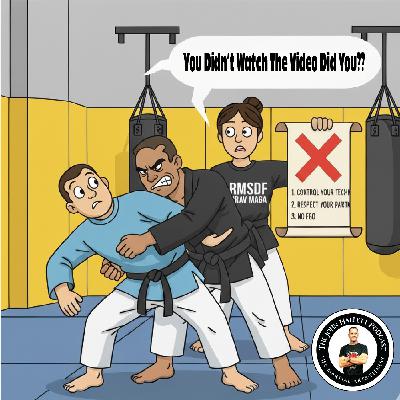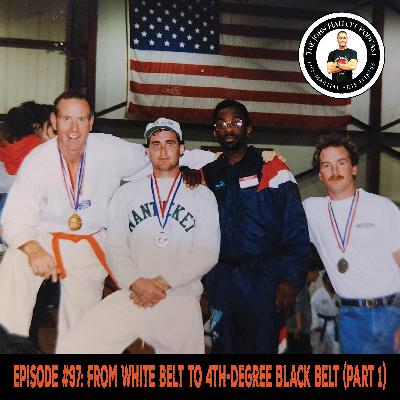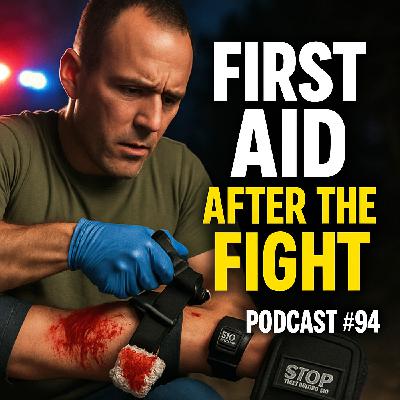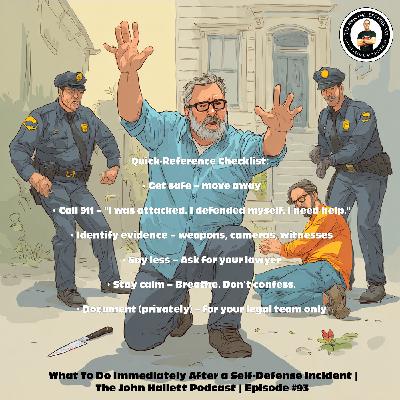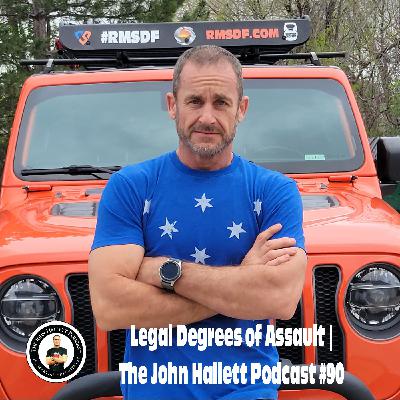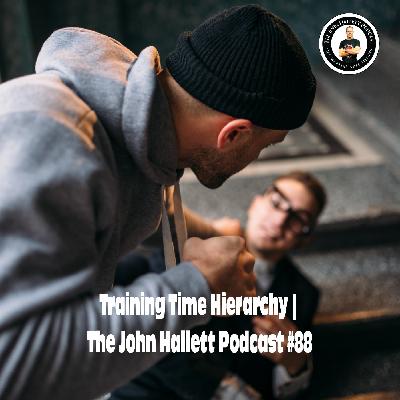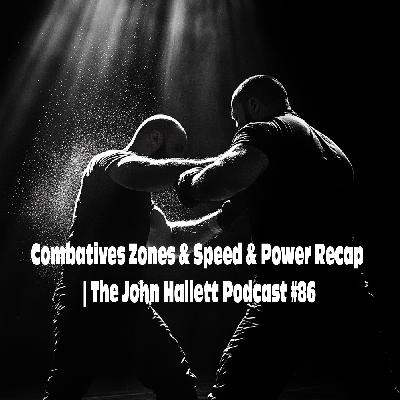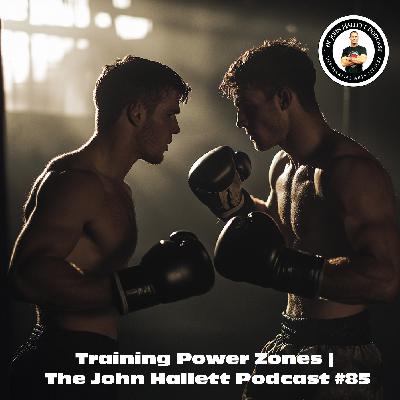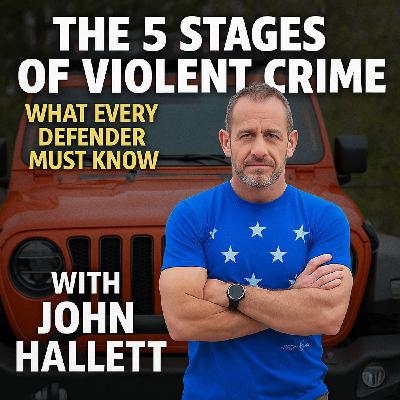Discover The John Hallett Podcast
The John Hallett Podcast

The John Hallett Podcast
Author: John Hallett
Subscribed: 0Played: 351Subscribe
Share
© All rights reserved.
Description
A podcast hosted by John Hallett. John is a small business owner, father, husband and fourth degree black belt in Krav Maga. John is on a journey to talk about the things that matter most in life for the everyday person. John owns Rocky Mountain Sefl-Defense and Fitness in Castle Rock Colorado. He often uses the lens of martial arts to discuss a wide range of topics. Take a listen and share this journey with others!!!
Visit the website at:
Martial Arts | Fitness | Krav Maga | Safer & Stronger (rmsdf.com)
Facebook and IG :
@RMSDF
Visit us in person at:
780 Kinner St Unit 1, Castle Rock, CO 80109 ·
142 Episodes
Reverse
Episode 100! A milestone conversation between John and Josh straight from the RMSDF gym.This one’s all about training etiquette — the unspoken rules that make you a great student, partner, and martial artist.From keeping your gear clean to controlling your ego, this episode dives into the habits that build respect and longevity in training. John shares lessons from decades of teaching Krav Maga and martial arts — and why etiquette is more than manners, it’s part of survival.You’ll laugh (especially when Josh gets punched), but you’ll also walk away with a deeper understanding of what separates good students from great ones.🧠 Key TakeawaysRespect comes first. Be a good human in the gym — respect your partners, instructors, and space.Tap before it hurts. Safety comes before ego. Let go early, and learn control.Train seriously. Have fun, but don’t goof off. What you do on the mat reflects how you’ll act under pressure.Keep yourself and your gear clean. Hygiene matters — no one wants to spar with smelly gloves.Listen when your instructor talks. The moment “Time!” is called, stop talking and pay attention.Good partners make great fighters. Look after each other — your partner’s safety is your responsibility.Control your ego. It’s coaching, not criticism. Your instructor isn’t yelling — they’re sharpening you.Don’t target joints or ramp up too fast. Train smart, stay in the proper zone.Don’t over-coach. Unless asked, let your partner learn.Remember — it’s not a competition. Krav Maga is about survival, not showing off.💬 Memorable Quote“Be respectful. Be clean. Train hard — but don’t be a jerk. That’s the best martial arts etiquette list you’ll ever need.”👊 Why It MattersEtiquette keeps training safe, respectful, and effective.Without it, people get hurt, burn out, or quit.With it, everyone improves faster — and the community grows stronger.John also ties this into the mindset of continuous improvement — teasing the next episode:“Black Belt Is the Beginning – Why So Many Fail to Get There or Truly Understand.”⚙️ Who This Episode Is ForNew Krav Maga or martial arts studentsParents of kids in trainingInstructors who want stronger class cultureAnyone serious about learning how to train safely and effectively🎧 Listen to this episode:Watch on YouTubeListen on SpotifyListen on Apple PodcastsAbout The Show:The John Hallett Podcast blends martial arts, mindset, fitness, and real talk.Hosted by John Hallett — 4th Degree Black Belt, gym owner of Rocky Mountain Self-Defense & Fitness, and founder of ClearSky.Training — each episode delivers real lessons from the mat and from life.
🎙️ Show Notes (Episode 99)
Title: Beyond the Basics: Training at the Advanced Level
Hosts: John Hallett with Josh Hammerling
Summary
John and Josh wrap up the black belt journey series with a look at advanced training and earning the black belt. From the pressure of instructor courses, to staying game-ready as a gym owner, to the nerves of testing under John Whitman, this episode gets into what it really takes to go beyond novice and into mastery.
Along the way, John also dives into the corruption of Big Pharma, the future of peptides, and why laziness is a bigger enemy than any opponent. Expect unfiltered truth, hard lessons, and a reminder that belts mean less than the grind you put in daily.
Key Topics
Advanced training expectations & intensity vs technical refinement
Black belt test nerves & the importance of mindset
The role of instructor training and staying sharp as a gym owner
Continuous improvement: “good enough” is never enough
Big Pharma corruption, peptides, and longevity talk
Laziness, excuses, and why movement beats stagnation
Learning Highlights
Game Ready Always: advanced ranks demand consistency, not convenience.
Mind Over Nerves: testing is as much mental as physical.
Never Stop Refining: every belt level will make your old self look unprepared.
Teach & Lead: advanced training is about lifting others up, not just yourself.
Who This Is For
Martial artists preparing for advanced belts
Instructors balancing teaching with training
Students wondering what “black belt” really means
Anyone battling self-doubt at higher levels
🎙️ Show Notes (Episode 98)
Title: The Grind Zone: Surviving the Intermediate Stage
Hosts: John Hallett with Josh Hammerling
Summary
Intermediate belts are where the honeymoon ends and the work begins. John breaks down plateaus, mental reps, and the difference between chasing numbers vs respecting the movement. From shadowboxing in hallways and job sites to Bas Rutten audio rounds, this episode shows what it really takes to move from “I’ve got it” to I’m actually getting good. Plus: why many quit here, how coaching accelerates learning, and why “good for your belt” isn’t the same as excellent.
Key Moments / Topics
The plateau: why progress feels slower after early belt jumps
“Good for your belt” vs true quality technique
Mental reps: visualizing like sport (football/baseball analogies)
Bas Rutten audio rounds, heavy bag & shadowboxing routines
Carryover from Taekwondo → refining Krav Maga strikes
Teaching as training: reps you get by coaching others
Dunning–Kruger danger zone at mid-belts
“Respect the movement,” not just the clock or rep target
Why removing strict rep numbers from advanced belt reqs may be healthier
Learning Highlights
Consistency beats novelty: show up, get reps, fight the plateau.
Quality > Count: don’t chase the spreadsheet; chase the skill.
Mental Reps Work: visualize the movement, timing, and next steps.
Teach to Learn: coaching exposes gaps and locks in fundamentals.
Slow is smooth: feel positions, fix errors, then add speed/power.
Who This Is For
Mid-belt students feeling stuck
Instructors mentoring intermediates
Athletes crossing over from other arts
Anyone tempted to “program hop” when the grind hits
Pull Quotes
“It’s not respecting the movement when you’re just racing the clock.”
“Good for a green belt isn’t the same as good.”
“Put in the reps—shadowbox, bag work, mental reps—everywhere.”
Mentioned
Bas Rutten audio workouts (shadowboxing / heavy bag)
ClearSky.Training audio workouts inspired by that format
🎧 Listen & Subscribe
Spotify
Apple Podcasts
Universal Link
YouTube Playlist
🎙️ EPISODE #97 IS LIVE
"White Belt to 4th Degree Black Belt – Part 1"
From Nantucket Island to 4th-degree Krav Maga black belt — John Hallett shares how it all started.
🥋 Real stories. Real grind.
👊 Sparring. Struggles. Success.
🧠 Mindset lessons from football fields to fight gyms.
📺 Watch now: https://youtu.be/ToXuknxr30o
📖 Blog + Show Notes: https://rmsdf.com/from-white-belt-to-4th-degree-black-belt-part-1-ep-97/
🎧 Listen & Subscribe:
Spotify
Apple Podcasts
Universal Link
YouTube Playlist
#JohnHallettPodcast #KravMaga #MartialArtsJourney #SelfDefense #TrainMoreSuckLess #WhiteBeltToBlackBelt #RMSDF
In Episode 96, John and Josh dive into the mindset battles every student faces—on the mat, in the gym, and in everyday life. From self-doubt during sparring to procrastination, negative self-talk, and the desire for shortcuts, this episode is a raw and relatable discussion on personal growth and what it really takes to earn mastery in martial arts.
They also explore the reality of time investment required to hit expert-level training hours—whether it’s 5,000 or 10,000 hours—and how that compares to the average martial arts schedule. If you’ve ever found yourself saying, “I’ll train tomorrow,” this episode is for you.
🔍 Show Notes – What You’ll Learn:
Why mindset is the real battle—and how to shut down the negative inner voice
How sparring should be mutual, not competitive
The importance of structured slow drills like offense/defense sparring
Why minimum standards are not enough—and what striving for excellence looks like
The 10,000-hour rule for mastery: realistic or unreachable?
Tips to work around injuries and keep training consistently
The importance of routine, discipline, and sustainable progress
Why “I am going to train” beats “I should train” every time
🔑 Favorite Takeaways:
“Sparring is not about domination—it’s about letting your partner work too.”
“You can’t master anything if you’re only training two hours a week.”
“Don’t let that little voice tell you to stop. Tell it to shut up.”
“You’re only as good as your last class. Show up. Give what you can. That’s progress.”
“Advanced techniques are just fundamentals done well under pressure.”
🎧 Listen & Subscribe:
Spotify: https://open.spotify.com/show/6hDh7OscpVMKLLY8rCvgqs
Apple Podcasts: https://podcasts.apple.com/us/podcast/the-john-hallett-podcast/id1651930801
Universal Link: https://redcircle.com/shows/a982e1e3-972c-4e9f-b369-6b29534df441
YouTube Playlist: https://www.youtube.com/playlist?list=PLIJr7pPF9el8qfN4mG9p8BxtuPKOpSBVn
Think you can “just kick ’em in the groin” or “throw one knockout punch”?
John & Josh break down 10 of the dumbest things people say about their self-defense skills—and why these myths could get you hurt. From overconfidence to bad YouTube advice, this episode is a reality check every fighter and would-be protector needs.
Train smarter. Fight better. Suck less.
In this vital episode, John Hallett and co-host Josh dive deep into the often overlooked yet essential side of self-defense—first aid and trauma response.
Covering everything from basic wound care to full-scale trauma kits, this episode is a wake-up call for anyone serious about defending life—not just during an attack, but in the chaotic aftermath.
Whether it's a sprained ankle, a head injury in the gym, or a life-threatening bleed from a violent encounter, you’ll walk away with practical, real-world advice you can apply today. It's not about fear—it’s about being prepared.
💡 “When you need it, you’re going to NEED it—and there won’t be time to figure it out.”
🔑 What You’ll Learn:
Why first aid must be part of your self-defense plan
The MARCH protocol and how to apply it
Why you should train with your first aid gear, not just carry it
The reality of head injuries, concussions, and how to manage them
Why scene safety and calling 911 come before anything else
How to prepare kids and families to respond calmly in an emergency
🧰 Tools & Tips Covered:
Tourniquets (including soft T options)
Israeli bandages & wound packing
Chest seals and makeshift alternatives
Narcan for opioid emergencies
Boo-boo kits vs. trauma kits
How to build a kit you’ll actually carry
🧠 Why This Matters:
Self-defense is more than fighting. It’s about keeping yourself and others alive when seconds count. Your ability to respond in a medical emergency may save a loved one—or even yourself.
🎧 Listen & Subscribe:
Spotify
Apple Podcasts
Universal Link
YouTube Playlist
Let me know if you'd like a
🎙️ The John Hallett Podcast | Episode #93
What To Do Immediately After a Self-Defense Incident
ClearSky Self Defense & Fighting System
After a violent encounter, your actions in the next 5 minutes could determine your legal and personal future. In this episode, John Hallett and co-host Josh break down the critical steps every responsible defender needs to take — immediately.
🔑 Episode Highlights:
Why creating distance and assessing is always step #1
How to properly call 911 (and what not to say)
What details to point out to law enforcement (evidence, cameras, weapons)
Why saying less to police protects you
The simple script to use:
“I was attacked. I defended myself. I want to speak to an attorney before making a full statement.”
Legal and mental aftermath: adrenaline crashes, gaps in memory, and the emotional toll
Why posting online can destroy your case — don’t do it
The importance of having an attorney ready before you need one
Why your training must include post-fight thinking and scanning
This episode also discusses why some of your biggest mistakes must happen in training — not on the street — and why mindset, movement, and the law are inseparable.
📌 Quick-Reference Checklist:
✅ Get safe – move away
📞 Call 911 – "I was attacked. I defended myself. I need help."
👀 Identify evidence – weapons, cameras, witnesses
🤐 Say less – Ask for your lawyer
😌 Stay calm – Breathe. Don’t confess.
📷 Document (privately) – for your legal team only
🧠 Learn More:
Explore this topic deeper with PDF resources, exclusive video training, and mentoring at:
👉 ClearSky.Training
🎧 Listen or Watch:
🎥 YouTube Episode
🔊 Spotify
🍎 Apple Podcasts
🌐 Universal Link
🛒 Support the Podcast:
Grab our new Fight or Flight Penguin gear at:
➡️ shop.RMSDF.com
➡️ shop.ClearSky.Training
🧢 Shirts, gear, and attitude — perfect for defenders.
The John Hallett Podcast – Episode #92In this episode, John and Josh unpack one of the most misunderstood—but essential—elements of effective training: failure. Whether you're in the dojo, gym, or a real-world encounter, understanding and managing failure rates is key to building real skills and survivability.🔑 Key Takeaways:The Ideal Failure Rate: 15–30% failure is the sweet spot. Below 15% means you’re not being challenged. Above 30%, frustration and bad habits creep in.Why Failure Matters: Real growth only happens under pressure. False confidence arises when training is too easy or too scripted.Progressive Resistance: Start slow, add light resistance, then escalate toward full, unpredictable scenarios.Adaptability is King: Students must learn to think on their feet—fail, recover, and keep going.Complacency is Dangerous: The attacker won’t follow a script. Don’t let easy training give you a false sense of readiness.Scenario Training Works: Reality-based drills build problem-solving skills, decision-making under stress, and mental toughness.🧠 Discussion Highlights:Blocking with forearms (not hands!)Training under fatigue and pressureManaging partner resistance levelsFalse confidence vs. real competenceThe dangers of over-coaching or under-resistingChildren and adults learning differently—but both needing challenge📌 Who This Is For:Krav Maga & martial arts studentsInstructors refining their curriculumSelf-defense students (at any level)Concealed carry or firearm defense practitioners🔗 Listen to This Episode:🎧 Spotify: The John Hallett Podcast🍎 Apple Podcasts: Listen on Apple🌐 Universal Link: RedCircle Hosting📺 YouTube Playlist: Watch Episodes Here🚀 Train With Us:💻 ClearSky.Training – On-demand reality-based self-defense training🛡️ shop.rmsdf.com – Self-defense gear, apparel, and supplements💬 Final Thoughts:Train smart. Fail just enough to grow. Because how you train is how you fight.
In this episode, John and Josh break down how stress affects your ability to see and hear clearly in real-world self-defense encounters. From tunnel vision to total auditory exclusion, they explore how high-stakes moments shrink your perception—and how proper training is the only way to combat it.Whether you’re a beginner or a seasoned martial artist, understanding how your body and brain react under duress could be the key to staying safe and staying out of legal trouble.What You'll Learn:What tunnel vision looks and feels like during a confrontationHow auditory exclusion can prevent you from hearing even law enforcement commandsWhy visual scanning and wide gaze training is criticalHow to expand your “perception cone” under pressureReal drills to help reduce blind spots and stay situationally awareKey Concepts Covered:Importance of post-engagement scanningMuzzle awareness under stress in firearms scenariosWhy kids and adults alike struggle to hear or see during drillsHow body language trumps words in identifying threatsReal-world implications of missing secondary attackers, exits, or police commandsTakeaways for Students:Learn to fight with your eyes open, literallyTrain your brain to stay calm and scan for threats or escape routesBuild muscle memory through reps and stress drillsDon’t assume you’ll hear commands in a high-stress moment—train for that realityBonus Discussions:How visual occlusion affects decision-makingUsing background noise and strobe lighting for stress drillsThe unique challenge of visual & auditory reduction for people with hearing lossNext in the Series:Failure Rates in Martial Arts & Self-Defense TrainingWhat To Do Immediately After a Self-Defense IncidentFirst Aid & Stop the Bleed Training (coming soon)Train More. Suck Less. Go Home Safe.Primary Hashtags:#JohnHallettPodcast#ClearSkyTraining#SelfDefense#SituationalAwareness#TunnelVision#AuditoryExclusion#RealWorldTraining#FightOrFlight#TrainMoreSuckLess#KravMagaSupporting/Contextual Hashtags:#StressTraining#AdrenalineResponse#MartialArtsMindset#Combatives#AwarenessIsKey#DefensiveMindset#CitizenDefender#SurviveAndThrive#ReactionUnderPressure#SelfDefenseTipsSUBSCRIBE TO LEARN MORE KRAV MAGA: https://www.youtube.com/c/ClearSkyTraining?sub_confirmation=1 Suckless Performance - Supplements https://suckless.co/Podcast: https://rmsdf.com/the-john-hallett-podcast-rmsdf/ Our Knife: https://shop.clearsky.training/product/clearsky-defender-1/ Sirt Laser Training Pistol:https://shop.clearsky.training/product-category/sirt-laser-training-pistols/ Learn More @ http://clearsky.training/ Shop: https://www.shop.clearsky.com/ Come and train with us in person @ https://rmsdf.com/
Legal Degrees of Assault: Know the Line Before You Cross ItSummary:In this episode, John and Josh tackle one of the most misunderstood—but legally crucial—topics in self-defense: the degrees of assault. They break down how slight changes in a confrontation can escalate your legal exposure from a slap to a felony. Whether you’re carrying a firearm, training in martial arts, or just trying to protect your family, knowing these distinctions can keep you out of jail.“That pillow didn’t justify the rock. You’ve got to match force with force—and be able to explain it.”🔍 What You’ll LearnThe difference between simple assault, assault with injury, assault with a deadly weapon, and aggravated assaultWhy context and perception matter just as much as physical actionsHow your response to a threat may legally shift depending on distance, timing, and escalationThe risk of under-responding or overreacting in a fast-moving confrontationHow weapons of opportunity—even a pen or curb—can change the legal equation⚖️ Real-World Scenarios Discussed:The pool party case where a brandished firearm went from unjustified to self-defenseThe risk of reacting to a perceived threat too quickly—or too slowlyInterpreting weird behaviors (like someone approaching while cleaning a knife)What counts as a deadly weapon (hint: it’s more than just knives and guns)Why jury perception and the “reasonable person” standard matter more than you think💡 Memorable Quotes“Even weirdos with knives can be a deadly threat—you better be ready.”“You can’t hit someone with a rock because they hit you with a pillow.”“Words plus threats plus action equals assault.”“Learn this stuff in class before you're forced to apply it on the street.”👥 Who This Is ForConcealed carry permit holdersSelf-defense students and martial artistsParents protecting loved onesAnyone serious about legally sound personal protection🛡️ Mentioned in This EpisodeRocky Mountain Self Defense & FitnessClearSky.Training – Online self-defense portal“Law of Self Defense” by Andrew BrancaUpcoming Episodes:Visual & Auditory ReductionFailure Rates in Martial Arts TrainingWhat to Do After a Self-Defense IncidentFirst Aid & Emergency Care for Defenders (Coming Soon)📌 Subscribe & ShareListen On Spotify:https://open.spotify.com/show/6hDh7OscpVMKLLY8rCvgqsListen On Apple Music:https://podcasts.apple.com/us/podcast/the-john-hallett-podcast/id1651930801Universal Link:https://redcircle.com/shows/a982e1e3-972c-4e9f-b369-6b29534df441Support the show:🛒 Shop.RMSDF.com | 🥋 Shop.ClearSky.TrainingPick up supplements, training gear, or a “Suck Less” tee to support the mission.
🔑 Episode Summary:In this episode, John and Josh dive into the five key elements of self-defense law—critical knowledge for anyone serious about protecting themselves or their family. These legal pillars form the foundation of any legitimate self-defense claim, and understanding them could mean the difference between freedom and prison.⚠️ Disclaimer: John and Josh are not attorneys, but their training insights are based on expert legal resources and real-world application.🧱 What You’ll Learn:1. InnocenceYou must not start or provoke the fight—verbally or physically. Even aggressive body language can work against you.2. ImminenceThe threat must be immediate. You can’t act on threats about tomorrow or vague aggression.3. ProportionalityYour response must match the level of threat. A punch does not justify deadly force unless serious harm is imminent.4. AvoidanceIf you can safely escape, do it—especially in front of a jury. You may have the right to stand your ground, but you may still face civil or criminal repercussions.5. ReasonablenessYour actions will be judged against what a “reasonable person” would have done. Your mindset, physical condition, and perception all factor in.💬 Favorite Quotes:“Please don’t hurt me” beats “Let’s go!”—especially in court.“Imminent doesn’t mean angry words. It means action is about to happen.”“You can’t smash someone with a rock because they hit you with a pillow.”“Avoid the fight if you can. Protect others if you must.”“Juries ask: Would a reasonable person have done the same thing?”🧠 Bonus Discussion Topics:Clenched fists as pre-fight indicatorsStand Your Ground vs. Duty to RetreatThe danger of escalating force too soonHow your perception may be legally relevantWhy it’s critical to train under pressure🔗 Mentioned in This Episode:ClearSky.Training – Online training portalshop.rmsdf.com – Gear & T-Shirts“Law of Self Defense” by Andrew BrancaPodcast #87: Situational Awareness ZonesPodcast #90 (Coming Soon): Legal Degrees of Assault🎯 Who This Episode Is For:Self-defense & firearms studentsConcealed carry permit holdersParents protecting their kidsMartial arts instructors seeking real-world contextAnyone serious about legal use of force in violent encounters📌 Subscribe & Support:Listen on Spotify, Apple Podcasts, YouTube & more👍 Like. 🔁 Share. 💬 Review.🛡️ Train More. Suck Less. Go Home Safe.SUBSCRIBE TO LEARN MORE KRAV MAGA: https://www.youtube.com/c/ClearSkyTraining?sub_confirmation=1 Suckless Performance - Supplements https://suckless.co/Podcast: https://rmsdf.com/the-john-hallett-podcast-rmsdf/ Our Knife: https://shop.clearsky.training/product/clearsky-defender-1/ Sirt Laser Training Pistol:https://shop.clearsky.training/product-category/sirt-laser-training-pistols/ Learn More @ http://clearsky.training/ Shop: https://www.shop.clearsky.com/ Come and train with us in person @ https://rmsdf.com/ #kravmaga #clearsky #JohnHallett #RMSDF #Castlerockcolorado
In this episode of The John Hallett Podcast, we tackle one of the most important—but often overlooked—principles in self-defense training: how to prioritize your training time.Whether you're a beginner or advanced, how you divide your time determines whether you actually get better or just stay busy. If you want real-world skills that hold up under pressure, you’ve got to train with purpose.⛓ The Hierarchy of Self-Defense TrainingHere’s the ClearSky training breakdown John shared:🥇 30% – Self-Defense Techniques (High Probability Attacks)Chokes (rear, wall, ground)Bear hugs, grabs, weapon threatsEscape & evasion drills“Train for what actually happens, not what you hope will happen.”🥈 25% – Combatives (Striking & Movement)Punches, elbows, knees, kicksPad work, angles, footwork“Your hands are your first weapons. But if you don’t train your timing—you won’t land a single one when it counts.”🥉 25% – Ground Fighting & GrapplingEscapes (mount, guard, side)Takedown defense, stand-ups“The ground is a brutal place if you don’t know what you’re doing.”💪 10% – Fitness & StrengthConditioning, explosivenessEndurance drills“If your skills fade when you’re tired, what’s the point? Fitness is the gas that keeps you in the fight.”🧠 10% – Mindset, Law & AwarenessDe-escalation, legal use of forceTactical breathing, situational awareness“Your mindset wins fights. If your brain shuts down, so does your body.”🎙️ Real Talk From the MatOn unrealistic training partners: “Hey man, I like you—but you're going too hard. I’m here to learn, not survive you.”On repetition: “Want to be a great striker? Try 10,000 reps. On a bag. At home. At the gym. That’s how black belts are made.”On training priorities: “Cool techniques don’t matter if you can’t breathe or recover under pressure.”On mindset: “If my arm gets blown off in combat, I’ll pick it up and beat you with it. That’s the level of mindset we want.”💡 TakeawaysTrain what’s most likely to happen. Not what looks cool.Condition your body AND your brain. Don’t gas out mentally or physically.Stay humble. Train often. Online or in-person—just train.📍 Want More?👉 www.ClearSky.Training 📍 Castle Rock, CO – One Month Free for Locals 🛒 Gear + Supplements: shop.rmsdf.com & shop.clearsky.training
The John Hallett Podcast | Episode #87Welcome back to another episode of The John Hallett Podcast! In Episode 87, we break down one of the most vital concepts in self-defense: Situational Awareness Zones.Whether you’re a seasoned martial artist or someone just starting their journey, understanding your environment can mean the difference between avoiding danger and walking straight into it. This episode is all about training your awareness like a skill—because it is one.🧠 “You’re Upping Your Chances”Early in the episode, John reflects on a conversation with a beginner student who was discouraged about defending against a larger attacker. His answer was simple and powerful:“You’re upping your chances. Nothing’s 100%—but you’re giving yourself a fighting chance.”That’s what training is really about. Not perfection. Not guarantees. Just stacking the odds in your favor through preparation and awareness.🟦 Blue Zone – Situational AwarenessThis is your default zone when you’re out in the world.You're calm, but switched on. You’re scanning your surroundings without looking paranoid.You’re not expecting a fight—you’re prepared to recognize a potential threat before it gets close.🟩 Green Zone – The Action ZoneWhen someone enters your space—maybe a bit too fast, maybe watching you—it’s time to shift posture and mentally prepare.It’s not go-time yet, but your mind is moving. This is your cue to reposition, plan an exit, or be ready to send a clear command: “Back off.”🟨 Yellow Zone – The Combat ZoneThis is within striking distance. The moment where the fight might erupt at any second.In this zone, hesitation is dangerous. Your training needs to kick in—striking, blocking, or gaining positional control. As John says:“Distance equals time. And here—you’re out of both.”🟥 Red Zone – The Clinch ZoneYou're now chest to chest, inches away from violence.There's no time to talk, only time to act. Clinch control, elbows, knees—this is full-blown combat, where your survival depends on your ability to stay calm in chaos.🎯 The Mission: Dominate the Angles, Control the FightEvery zone has a mindset, a strategy, and tools. The clearer you are on which zone you’re in, the faster you can adapt—and the more likely you are to survive.🎧 Tune InListen to the full episode for insights, examples, and tactical takeaways:🎙️ The John Hallett Podcast #87 – Situational Awareness Zones📲 Available on Spotify, Apple, YouTube🌐 Learn more: www.ClearSky.TrainingForeign. Hey, everybody. Welcome back. How you doing, Josh? I'm good. How are you? Got my coffee. I'm feeling good. You got your coffee? Yeah, I'm only on one cup of coffee here, so come on. Yeah, I might have to hit pause. So. Been a good week. A lot of new things. Training hard. I got. Just got crushed by big Jeff yesterday. My chest is killing me. No, that's good. £280 on me or whatever. I don't know. Right. Oh, it's tough when you got that big guy on you, man. Yeah, Serious. It just is. Yeah. I was just saying to a beginner in the. In actually, Jeff's class, Jeff was covering for Ryan today that, you know, sometimes I'm just trying to wear down the big guy. Like, she's like, I'm not going to be able to defend it. Yeah, you're upping your chances. When you do self defense, martial arts, whatever it is, you're upping your chances or survival. Nothing's 100%, you know, and sometimes people are like, I'm not going to be able to do it. Yeah, youmight not be able to do it. It's called winning and losing and somebody being bigger and stronger. But I said, you know, sometimes it's about not making a mistake and just wearing somebody down until they make a mistake or get too exhausted and it kind of starts to equal things out. Yeah, yeah, yeah, it's true. When you get gassed, you get gassed, right? Yeah, that's. That's a tough one when you do. Oh, I guess. Do I have this up on the screen already? You do. In here today we're talking about situation awareness, so a good topic. You know, just being aware can keep you out of a lot of trouble right from the get go, you know, just avoiding it. Right. I like that you put in there. Don't. You know, not paranoid. You ever seen that one guy for me? You mind the guy standing there in the line just like doing a crazy surveillance scan every 10 seconds. Yes. That's what told me like a year ago that you were in, like, I don't know, a person. Were you. Was she shopping for purses or something?Wherever you guys were. The outlet mall. All right. I may have been practicing there. People are like, that dude's gonna steal something. No, I'm crazy. I did feel like I intimidated everybody in the room. And I was like, well, maybe this isn't smart. Yeah. So, yeah, even one of our teenagers was just in Paris and he said, I saw a guy got jumped and, you know, Kind of avoided it, you know, seeing it and seeing something happen. Even like in the real world, you know, coming from a small town like Castle Rock, sometimes that, you know, opens up, like, oh, these things do happen. It can happen. I mean, it can happen in Castle Rock. I mean, who knows? You never know. I mean, they just found that dead body off a Larkspur exit. Right. We should talk about that. No, but I mean, again, that's situational awareness. Even someone seeing that body, like indicators around you that things are going bad, you know, it's. It's real. Yeah. Just seeing somebody get jumped. So we'll jump right into it.Blue situation awareness zone. Be aware, not paranoid. Be covertly aware of your surroundings. Distance is fluid and may change in a split second. Right. Just, you know, you're walking around kind of every day. Should be your state. Shouldn't be paranoid especially, and jumpy and getting yourself all freaked out. I mean, most of the time, depending on where you're at, it's a pretty low probability situation now, you know, you just see somebody get jumped. Okay. You know, this walk in the park or wherever the heck you are just changed. So. Yeah. Up in your level a little bit. Seeing some violence in that area, even if you can avoid it, going, okay, this might not be a good area just in general. So. Yeah. And you don't know where that thing's going. Like, it could escalate from a simple assault to somebody pulling a gun or a knife or something weird. And it changes the whole dynamic. So if you can see it before it gets to you, get the heck out. I mean, like, you always tell me the firstrule is go home safe. Yeah. If you can just get out of there, be fantastic. Right? I mean. Yeah. But, you know, being. Being aware and. And you're not. Your head in the phone, as everybody says, or just looking around, that helps you out a lot, you know, to avoid getting attacked by that bigger guy, you know? Yeah. Get distance. Get distance. Green in an hour. More of an action zone. Somebody's close and we're thinking there is a potential threat there. You know, their posture shift, somebody might be staring at you. You know, you got to be prepared to move or strike if the situation escalates and, you know, they get closer. You know, that 21ft is not that far. Yeah. Oh, my gosh. They cover that in the blink of an eye. Yes. It's crazy how fast. I mean, a good athlete, somebody younger. Yes. You know, I've seen long legs cover three feet a step. And it's like, oh, oh, and they're on me. Yeah, exactly. I mean, trying to just run with somebody that's got longer legs. I mean, one of my oldtraining partners, Big Greg, I mean, I forgot how tall he was, but he was, you know, averaged around 275, 285. That was my best mile time that I was just running from him. I was just trying to stay ahead of him and his longer legs, man, for a big deal, he was, you know, I don't know how many steps, but behind me most of the way. I don't know if I lost him. I can't. It's been a number of years that I did that mile with my knees and stuff, but that was my best one, just trying to run from him. But, man, those footsteps were right behind me, you know, and it. It just sneaks up on you. And distance is just so scary. I mean, how fast everything changes. That's why you got to be aware as much as you can without looking like Josh did at the purse store, like a personal bodyguard. All right, I admit that one. I probably screwed up. Let's move on. Let's move on. Well, hey, failure is good and going, you know, so, hey, here's a video of you out. You know, like, that would be great to see. No, weactually see it. It changes it. You're like, oh, man, what a jackass. I was right. And you can see that. Yeah, in video would be great. Maybe we can do a membership for that. We'll follow you around. Let's. Let's. Let's talk about that one before we put that one out there. I don't leave the house. You know that. I don't leave the house. I know. Yellow chem combat zone, you know, six to nine feet, strike or defend. And you're in the reactionary gap here. If you're behind that. We constantly talk about that. Hesitating. Yeah. Oh, man. You know, it's getting close here, and if you're behind the eight ball, so to speak, you're in trouble. You know you're in trouble. They hit you first. That can be all they need because you're behind. Yeah, you know, it's. It's a tough, tough position to be in when you are. Do I need to hit this person? Yeah, sometimes old, you know, safe than sorry and all that stuff comes into play here that you've got to feel justified. But, man, if you're behind, thatsucks for you. Yeah. And then I gotta start thinking with my legs more, especially in that six to nine feet. If I do have that opportunity, if I am aware I can do the kickoff, which I don't do. Like, I always want to go to hands for some dumbass reason. Well, you know, we talked about that. I don't know if we talked about it on the show last week, but. But you know, when you do a front kick at the wrong time and you end up on your butt, so that's tough. They're great. Like any tool, it's great when you deploy it at the right time, but yeah, when you deploy it at the wrong time, it's
Welcome to the John Hallett PodcastHey everybody, welcome back to the John Hallett Podcast! Today we're diving deep into combative zones and action zones — the various distances and decision points you face in a real-life self-defense situation. These are critical concepts for anyone serious about their personal protection, especially those training in Krav Maga and other martial arts.We want to thank our growing community of listeners. If you want to support the podcast and our mission, check out SuckLess.co, our online training portal ClearSky.Training, and of course, our in-person programs at Rocky Mountain Self Defense & Fitness.Training the Mind and the BodySelf-defense isn’t just a mental game. It’s not enough to understand concepts — you have to train them physically. You have to push yourself, challenge your excuses, and build real-world skills through hard training.That’s why I still do things like cold plunges. Not because I love it, but because it builds mental resilience. That mindset translates directly to self-defense. The world isn’t getting safer, and we all need to be ready to act, not just think.Let’s Talk ZonesWhen we break down combative zones, we’re talking about the physical distance between you and a potential threat. Each zone requires different skills, awareness, and action. Here’s a breakdown:Zone 4: Awareness (15–25 ft)This is your first line of defense — the decision-making zone. Can you spot a threat before it becomes an attack? You have a few seconds (maybe less) to:Recognize threatsCreate distanceCall 911Use command presence or verbal de-escalationThis zone is fluid. Someone athletic can close that gap in under 2 seconds. Train your awareness and threat recognition here.Zone 3: Engagement Prep (10–15 ft)Things are escalating. You may need to:Use tactical movement (create angles or barriers)Deploy a front kick to keep someone backConsider a weapon draw (only if truly justified)Training the front kick is essential here. But if you mistime it, you’re vulnerable. Practice with movement. Don’t just hit pads.Zone 2: Striking Range (5–10 ft)This is where people freeze up. You’re now in a fight whether you like it or not.You must strike first if the threat is imminentWeapons like knives or guns may come outThis is not the time to reach for pepper spray or a firearm unless you’ve created the space to safely do soZone 1: Clinch / Close-Quarters (0–5 ft)Welcome to the worst-case scenario. You’re being grabbed, taken down, or attacked with deadly intent. Now it’s:Elbows, knees, headbutts (if trained)Weapon redirection and controlRelentless attack until the threat is neutralizedLadies: if someone is close enough to grab you, there is no half-measure. Be overwhelming in your response. Training breeds confidence and control in these critical moments.Reality-Based Training: Citizen Defender ClassThis is exactly what we do in our Citizen Defender class at RMSDF. You can’t just train on a flat range and expect to perform under stress. You need:Stress inoculationScenario drills (Quantum Leap drills, for example)Close-quarters decision-makingWe train everything from pre-fight indicators to 911 protocol and what to say after a defensive incident. These are the real-life details that make the difference.Don’t Wait. Train Now.Every day you delay is another day you remain unprepared. Our Clear Sky Training Portal lets you train from anywhere. And if you’re local to Castle Rock, come train in person. You don’t need to be fit. You just need to start.And for new listeners: we're offering one month free to get started. No excuses. No delays.Visit RMSDF.com and ClearSky.Training to start your journey. We promise, you can do this. You just have to show up.Up Next on the Podcast Stay tuned for future episodes on:Time Hierarchy in Training5 Elements of Self-Defense LawDegrees of AssaultThe Truth About Martial Arts Failure RatesWhat to Do After a Self-Defense IncidentTrain smart. Train often. And always remember: suck less every day.https://youtu.be/FLajh83fqkA
Hey, everybody, let's see if we can get this one done without Josh. He is training in Minnesota with Nick doing another level of citizen defender. One might ask, why am I not there? They're doing the last level that Bill and I did, so they're getting it done. Good luck to those guys. I guess Josh already got need in the head in a drill by the one and only. All right, Minnesota Martial Arts. Now I'm gonna black on blank on his name. That is terrible. Oh, well, Greg Nelson. I had Todd Fosse, that's the instructor for ids, so mixed up those names. So I was gonna bring on Leo, my French bulldog, but he decided to work in the office with my wife. He's more popular today. He usually joins me in the afternoon, but he must be boycotting me. He is much better looking than Josh, but, you know, some people might argue. So today we're talking about training power zones. These are really important, guys. I'll bring up the slide from our Clear Sky Dot training. Oh, where is it? There it is. Website where you can train with us online. That's great for our students. You know, get on there, get in it. There's a ton of stuff, including testing for each belt level that is required here at Rocky Mountain Self Defense and Fitness, our home base here in Castle Rock, Colorado. So look, guys, I remember being a white belt and kind of my instructor calling me the wild and crazy one, the one and only Master Miller from Nantucket Taekwondo. He was always telling me to slow down. I had just came off high school football, and I just knew one thing like, go hard, go 100%. And that leads to injuries and a whole ton of other things that can happen in that 100% all out. And I'm constantly telling beginners, slow it down, slow it down. And you know what I see? Looks like I was going slow and. And you're all going. Or we are all going way faster than we think. You know, standing off to the sidelines, you start to see it. And you know, one thing I tell people, I've watched you hit the bag at 100%. You're pretty darn close to that in that drill or whatever we might have been doing. So to quickly summarize, zone one is zero to 20. Zone two is 20 to 40% speed and power. So zone three, 40 to 60. Zone four, controlled speed and power. And zone five, 80 to 100. And we're leaving that to testing. You know, once in a while type of training where you can get hurt, but we need to do that. Sometimes test our mental toughness and put us under that real world stress. But the likelihood of getting hurt, injured on those always goes up. So we don't want to spend much time in zone five at all. Now look, zone one, it's on the slide a bit here, but I'm looking on my bigger screen because of my old eyes. Slow is smooth. You know, if you learn slow, you can get this stuff down. You know, focus on precision, timing, the mechanics. You're really going way slower than you think you should. There's really no power behind everything you do, you know, we'll call it slow touch sparring. When we're doing sparring at this level, it's just slow. It's just landing the light touch. Just. You're not even going to knock over that glass of water. I always kind of joke around and say, you know, unless you have a sippy cup at the dinner table, you know, you should be able to reach out and touch somebody without smashing them. You know, you want to build clean habits and good muscle memory here. You want to learn more on quote unquote muscle memory? Check out Andrew Huberman's podcast. That's fantastic. Neuro guy. I forget his whole repertoire. But we were not going to get into Andrew Huberman. So, you know, the philosophy here is slow is smooth and smooth is fast. One of my first levels, I can't remember the first or second. And I had a guy that I was training with in the hotel after, and he said to me after the test, wow, I kind of thought you were really slow and wonky, some things of that effect. And, and I said, you know, why'd you think that? Oh, when we were training, you just did. Everything was really slow. Like I'm just trying to get it down so when I do go fast, the wheels aren't falling off. You're building good habits. It pays off in the long run. You know, zone two, where, you know, we're moving up a little bit, 20 to 40%. But it is still pretty darn slow here, guys. 20 to 40%. Not that fast at all. Want our reactions to become natural in these. Sorry to click the slide. For those of you guys on YouTube, you can check these slides out without even visiting our portal or signing up for a low cost membership on there. All this stuff takes time and until I hit Powerball, I'm trying to make some money. All right, let's see. Focus, flow control, consistent technique. Being able to do it time after time without your, let's say uppercut, you know, breaking 90 degrees being too far away from the person. We're doing this in self defense. You know, you're building those good habits that I'm using this tool. It's slow enough to recognize. I have an uppercut, elbow, I have whatever technique, a knee strike. Hey, they're a little bit further away. I need to go to a kick or they're further away. I need to go to an advancing kick pick to keep my tools on this guy and to stay engaged, right? Power is really low to moderate. It's not gonna cause bruising. Most people aren't going to say ouch when you hit him at 20%. You know, you get up to 40, you know, depending on somebody, but it starts to get you accustomed to getting hit. We even say with our kick shields, you're getting used to getting hit. So this is not a big shot shock in an actual fight. And a lot of people fool themselves and think they're going to be fine. And then there's utter shock on their face when they actually get hit. Even remote, even at 50%, never mind somebody hitting you at full speed. So we want to kind of get used to getting hit and sparring and all that type of stuff at this 20 to 40 zone, get comfortable with it. You know, it doesn't happen overnight. We want to be able to groove in the movements. You know, safe repetition builds confidence. You know, you're not. Your partner's not freaking out and doing weird things on you because you're just going so fast and out of control and they're just trying to stay the heck away from you. We want to spend most of our training time in zone one and two. That's 60%. You know, if you kind of do the math on those, we're in there. It's a good, good zones to be in. My favorite two zones, constantly saying, if you don't see the fight slow, you're not seeing it fast. You're just fooling yourself. You're just windmilling in, you're just spazzing out. You know, hey, when in doubt, be aggressive, spaz out. You know, by all means, windmill in. But man, I don't want to have to resort to those type of things. Zone 3 is at 40 to 60%. Smooth is fast, right? Focus on realism without recklessness. Again, nobody wants to be your partner when you're crazy. Speed's moderate. Our power is controlled and clean. You're able to stop that punch. You're going slow enough that you can stop the strike. You know, your partner maybe moves a little bit under Unexpectedly, you're still able to control that. And that's a thing that takes time. It's repetition, like everything else. Repetition, purpose, add pressure while still staying sharp. You know, we're going to spend about 20% of our training time on this. And one note on all of these. You know, they're great to do on a heavy bag. You know, when you're kicking a kick shield, you can practice these things, shadow boxing without a partner and kind of feel your own speeds and try to figure that out. And, you know, when in doubt, video yourself. Be your own coach. You know, watch yourself, try, like full speed and then go, all right, let me cut that down in half and really try to relate that. It's a tough thing to do. It's a tough thing to even watch and kind of tell, but you just have to do it. It's a tougher things for coaches. You know, figuring out people and, you know, their different speeds and knowing, you know, hey, that guy is actually extremely fast. I think of coach Ben. He's extreme explosive and fast, more so than the average person. So watching different people, it's always a challenge for coaches to, you know, help that person along their journey. This 60 to 80, I guess that's where I'm at. Timing under pressure. Zone four is where we're at. Sorry, I need Josh. Timing under pressure, speed. You know, you're going fast here. Power's high, but with restraint, you know, you're still able to pull it off even if you're hitting them pretty hard. You were. You were dialing it back. That happens to me, you know, quite a bit at this speed that, you know, something happens whether, you know, you get away from yourself a little bit. You know, a lot of times a person moves, you're still able to pull the brakes. Even though you probably hit that person at 50%. But you were, you know, you dialed the back 25%. It's a tough thing to do and recognize in fighting. You know, I want to find my cracks in my technique. You know, the wheel, you know, things start, you know, coming off, coming unhinged. The wheels are coming off the car at this, and you really start to recognize, I should be spending some more time in zone one or two, possibly to kind of fix those errors that were happening under that type of speed and stress, you know, 15% of the time. Zone five. All right, 80 to 100. That's a stress test. What are you doing? It's probably in an advanced test is where we're going to see this. And I actually Just updated these slides here on some of this. I guess I added it on mine, but not on yours because we've got takeaways coming up next. But, you know, you're going max speed and max power, you know, simulates a real fight stress. But we're rarely doing this right because of that high risk of injury, you know, a concussion, all that type of stuff, or training this fast. We don't want to do it that much, but we have to do it sometimes. I'll use the NFL a
🎥 NEW VIDEO & Podcast: The 5 Stages of Violent Crime – What You NEED to Know to Stay Safe📍 From RMSDF & ClearSky Training | Hosted by John Hallett & Coach JoshEvery violent encounter follows a pattern—and if you don't know the stages, you're already behind.👀 Learn how to recognize danger before it becomes an attack.🥋 Hear real training stories, law-of-self-defense insights, and why most people are training the wrong way.⚠️ Discover why situational awareness, mindset, and movement matter more than technique alone.In this video, we break down:Intent – The invisible beginning of every attackInterview – How predators test their targetsPositioning – Why space matters more than strengthAttack – What you MUST be ready to do under pressureEscape/Exploit – How to end it and stay out of court🛡 This is reality-based training—not sport. It’s not about trophies. It’s about going home safe.🎯 Watch. Learn. Train. Repeat.📲 Want to train in person? RMSDF.com🌐 Train anywhere with us at ClearSky.Training🧢 Support the podcast & grab gear: SuckLess.co👇 Drop a comment if you've ever experienced any of these stages—or if this video opened your eyes.#KravMaga #SelfDefenseTraining #RMSDF #ClearSkyTraining #SelfDefenseMindset #SituationalAwareness #PeacefulWarrior
Core Training Categories - ClearSky Training System | John Hallett Podcast #84
Stop Trusting Your Gut - It's Fat & Is Lying To You - Kids In Team Sports Vs Martial Arts
ClearSky - No Way As A Way - Let Go Of Your Mind
The What If Question Answered
Student: “What If There Are Dragons & Unicorns?”
It’s The Right Move @ The Right Moment.
The Situation Sets the Strategy
The Peaceful Warrior Code:
“We train to stay calm in chaos. To end the fight before it starts. But when the line is crossed—we strike with purpose, precision, and power.”


